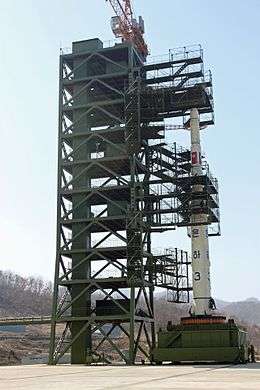National Aerospace Development Administration
|
Kukgaujugaebalkuk 국가우주개발국 | |
 The NADA insignia | |
| Agency overview | |
|---|---|
| Formed | April 1, 2013 |
| Preceding agency | |
| Jurisdiction | Government of North Korea |
| Headquarters | Pyongyang |
| Agency executive |
|
National Aerospace Development Administration (NADA; Chosŏn'gŭl: 국가우주개발국) is the official space agency of North Korea, succeeding the Korean Committee of Space Technology. It was founded on April 1, 2013.[1]
The current basis for the activities of NADA is the Law on Space Development, in 2013 the 7th session of the 12th Supreme People's Assembly was passed. The Act sets out the North Korean principles of peaceful development of space determines compliance with the principles of the Juche ideology (North Korean ideology) and independence, as well as the aim of solving scientific and technological problems of space to improve the economy, science and technology.
The law also regulates the position of the NADA and the principles of notification, security, research and possibly compensation in relation to satellite launches. The law calls for cooperation with international organizations and other countries, the principle of equality and mutual benefit, respect for international law and international regulations for space. The law also opposes the militarization of space.
Korean Committee of Space Technology

In 1980, KCST, the Executive Space Agency of North Korea, started research and development with the aim of producing and placing communications satellites, earth observation satellites and weather observation satellites.
International legal regime of North Korea's space activities
In 2009, North Korea entered to the Treaty on Principles Governing the Activities of States in the Exploration and Use of Outer Space, including the Moon and other celestial bodies in, and the Convention on Registration of Objects Launched into Outer Space Objects.[2]
Logo
The emblem of NADA consists of a dark blue globe with the word Kukgaujugaebalkuk (National Space Development Administration) in white Korean letters on the bottom, DPRK (Democratic People's Republic of Korea) in light blue letters on the top, the constellation of Ursa Major, NADA in white letters in the middle, and two bright blue rings symbolizing satellite orbits and the intention of place on all orbits of satellites. The logo is described as representing the agency's "character, mission, position, and development prospect". Ursa Major is intended to symbolize and glorify North Korea as a space power.[1][3]
The Western media point out that the logo strikingly resembles to NASA's logo — both with blue globes, white lettering, stars, and swooshed rings.[4][5][6]
Launch history
This is a list of satellites launched.
| Satellite | Launch Date (UTC) |
Rocket | Launch Site | Status | Purpose |
| Kwangmyŏngsŏng-1[7] | 31 August 1998 | Paektusan | Tonghae Satellite Launching Ground | Failed to reach orbit | Technology experimental satellite |
| 4 July 2006 | Unha-1 | Launch Failure | Rocket test (See 2006 North Korean missile test) | ||
| Kwangmyŏngsŏng-2 | 5 April 2009 | Unha-2 | Tonghae Satellite Launching Ground | Failed to reach orbit | Communications satellite |
| Kwangmyŏngsŏng-3[8] | 13 April 2012 | Unha-3 | Sohae Satellite Launching Station | Launch Failure | Observation satellite |
| Kwangmyŏngsŏng-3 Unit 2 | 12 December 2012 | Unha-3 | Sohae Satellite Launching Station | Successful launch | Observation satellite |
| Kwangmyŏngsŏng-4 | 7 February 2016 | Kwangmyŏngsŏng | Sohae Satellite Launching Station | Successful launch | Observation satellite |
Future projects
In 2016, Hyon Kwang Il, director of NADA's scientific research department, said they planned to launch more satellites before 2020, including a geostationary satellite. He also said that he hoped they would "plant the flag of the DPRK on the moon" within 10 years.[9]
See also
References
- 1 2 Pearlman, Robert. "North Korea's 'NADA' Space Agency, Logo Are Anything But 'Nothing'". Space.com.
- ↑ "KCNA Report on DPRK's Accession to International Space Treaty and Convention". Korea News Service (KNS). Retrieved 8 May 2015.
- ↑ "National Aerospace Development Administration of DPRK". Korea News Service (KNS). Retrieved 8 May 2015.
- ↑ "North Korea names space agency 'NADA,' mimics NASA logo". CNET. April 2, 2014.
- ↑ "North Korea's space agency's logo means nothing — literally". Business Insider. February 9, 2016.
- ↑ "North Korea steals NASA logo, but names space agency NADA (which means 'nothing' in Spanish)". Daily Mail. 2 April 2014.
- ↑ "Despite Clinton, Korea has rights". Retrieved 8 May 2015.
- ↑ Josh Levs, CNN (12 December 2012). "N. Korea's launch causes worries about nukes, Iran and the Pacific". CNN. Retrieved 8 May 2015.
- ↑ Talmadge, Eric (4 August 2016). "North Korea hopes to plant flag on the moon". AP.